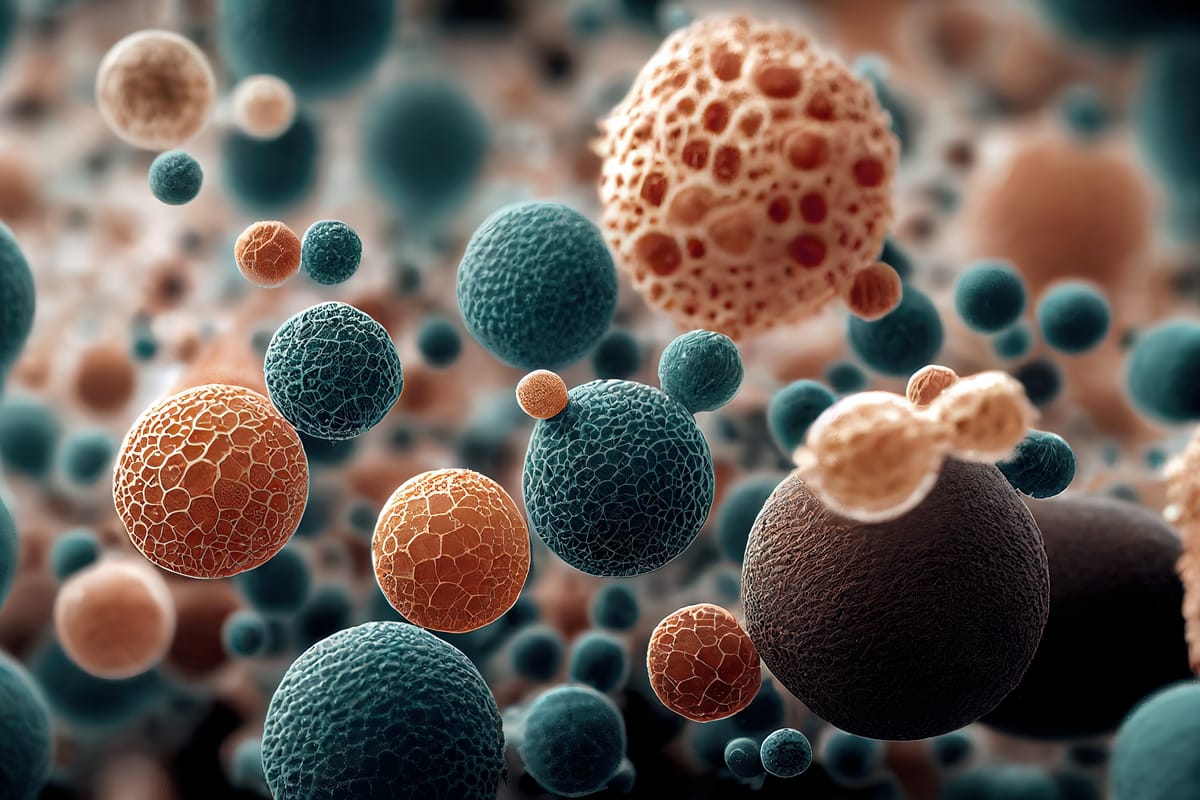Why Merging Biology With Economics Can Improve Profitability & What Can Nanoparticles Do For Probiotics?
Selecting for growth and reproductive traits can lead to significant increases in ranch profitability. And novel research into a method for supplement delivery was able to protect a microbial product from the rumen environment.

In this week's R2R Edition:
- Selecting for growth and reproductive traits can lead to significant increases in ranch profitability. Using the correct production traits helps to align financial, genetic, and production plans.
- Novel research into a method for supplement delivery was able to protect a microbial product from the rumen environment and could be a valuable technique for probiotic delivery into the large intestine.
Breeding & Genetics
Biology + Economics = Greater Profitability for Brazilian Ranches

The high-points:
- Brazil houses roughly 23% of the cattle on earth but produces 17% of the beef, suggesting inefficiencies in the beef production systems.
- Researchers in Brazil tested the impacts of genetic selection on the revenue for Brazilian cow-calf ranchers raising Nellore cattle.
- Selecting for increased average daily gain, ribeye area, and lower age at first calving leads to the most significant increase in profitability for an operation.
What you need to know: Currently, in Brazil, beef production is lower than the number of cattle and landmass in use would suggest. The researchers in today's paper mention that Brazil houses roughly 25% of the cattle on earth but produces 17% of the beef – implying that there are inefficiencies in the beef production systems. Improvements in these practices could positively impact the profitability and sustainability of the country's beef production.
Researchers in Brazil estimated the economic impacts of genetic selection for Brazilian cow-calf ranchers raising Nellore cattle (Brazil being the largest breeder of Nellore) by calculating a value called "economic value." Economic value compares the difference between profits before and after improving a single trait, with all other traits remaining unchanged. For example, increasing yearling weight but not affecting birth weight or feed efficiency. Researchers used this method to identify traits (i.e., weaning weight or pregnancy rate) that had the most significant effect on profitability. For example, increasing yearling weight but not affecting birth weight or feed efficiency.
The researchers included all typical ranch costs in their evaluation, like feed, mineral supplements, vaccines, dewormers, semen, hormone protocols, utilities like electricity, and staff, to name a few. The idea was to capture the complete picture of what traits impacted the rancher's bottom line and which traits allow ranches to minimize costs, maximize revenue, and improve profitability.
A majority of operational costs were made up by feed, 72% to be exact. The magnitude of this expense creates a sizeable economic benefit if a ranch can decrease the feed required to produce the same amount of output. These traits include feed efficiency, pregnancy rate, and age to first calf.
The most economically important traits were directly related to feed consumption, likely because of the impact highlighted above. Pre-weaning average daily gain had the most significant impact on ranch profitability – both pre-weaning and post-weaning were some of the most influential traits. This was likely because animals destined for slaughter required less time to reach a weight adequate for slaughter. It is important to note here that genetic selection should not be exclusively based on pre-weaning performance due to the dam's impact on performance during this time.
Age at first calving was the second most valuable trait. Cows that calve at younger ages can produce value for the operation sooner, essentially reducing inputs (feed) for the output (calf). One note is that age at first calving is a lowly heritable trait, so this value is not likely to change drastically with selection.
Calving interval, another important measure of fertility, had a moderate impact on profitability. However, it was responsible for the most significant losses and the highest revenue of any trait measured. The expenses came from the increased production of calves over a shorter period of time, increasing the ranch's total feed and care costs.
Feed efficiency did not significantly affect revenue, as its contribution is solely through lower feed intakes, decreasing feed costs for an animal to reach slaughter weight. This saves the operation money but does not create additional output (i.e., body weight or marbling), which is why there is not an impact on revenue. Being that this trait only affects one side of the "equation" (i.e., inputs but not outputs), its impact on profitability was lower than other traits. However, feed efficiency is still an important trait when selecting profitable and sustainable animals. In this study, it represented a decrease in feed costs of 1.9% or savings of $2.79 per animal per year.
Important to note:
- This study was conducted on Nellore cattle and Brazil; these numbers will differ for each country and breed. However, these values can be helpful conceptually to see how traits impact economics, and this research could spark similar evaluations in the US.
- These are single trait changes and do not consider interactions that can change one trait by selecting for another. For example, the selection of greater yearling weights can increase the birth weight inadvertently.
Industry application: Selecting for traits like average daily gain, ribeye area, and lower age at first calving leads to significant increases in ranch profitability. However, all the tested selection criteria showed improvements in the profitability of an operation. Understanding how these performance traits impact the bottom line is, as the authors state, "...essential to establish benchmarks and goals, to align the financial, genetic improvement and production plans, avoiding future issues that may compromise profitability and sustainability in the cattle operation."
Read more about it:
Wiley Online LibraryFlávia M. Souza
Nutrition
Nanoparticles: the future of animal supplements?

The high-points:
- Lactic acid bacteria improve both rumen fermentation and silage quality in the cattle industry.
- Tested delivery of bacteria to the large intestine by using a technology called nanofiber microcapsules that surround the bacteria.
- The nanofiber coating protected the product from being released into ruminal fluid but did not affect the large intestine due to over or under-encapsulation.
What you need to know: Lactic acid bacteria (LAB) improve both rumen fermentation and silage quality in the cattle industry (see the previous R2R for more on these bacteria). The large intestine benefits of LAB supplementation have been demonstrated only in the pre-ruminant calves. The large intestine of calves supplemented LAB show decreased inflammation and improvement of the microbiome population, with more beneficial bacteria and less harmful ones. However, supplementing LAB to improve the large intestine microbiome is complex in an adult ruminant. The many ruminant stomachs can interact with the bacteria, impacting their ability to travel to and be beneficial in the large intestine.
This research tested if LAB could travel to the large intestine successfully using a technology called nanofiber microcapsules. This coating surrounds the bacteria and protects them from the digestive system environment, potentially allowing the particles to stay intact until they enter the large intestine, where the bacteria are to be released.
Researchers compared the ability of these encapsulated bacteria (ELAN) to non-encapsulated bacteria (LANP), both in the ability of the capsules to stay intact in the rumen (simulated rumen via in-vitro fermentation), as well as the ability of both products to make it to the large intestine intact after traveling through the digestive tract of cattle.
The coated ELAN capsules had little effect on gas production or insoluble fraction of the rumen fluid (in-vitro). These two measures, gas production and insoluble fraction, can assess how much fermentation is occurring and if the encapsulated LAB bacteria hindered or helped it (the goal was to see no change, as that means the capsules did their job). These results suggest that the nanofiber coating protected the product from being released into the fluid.
However, ELAN did elevate the pH and decreased lactic acid production while simultaneously lowering the quantity of microbial cell protein and ammonia-nitrogen. Increased pH is the opposite effect that the encapsulated bacteria would have, and so this change is likely due to a bacteriostatic effect (inhibiting bacterial growth) of the capsule coating, chitosan.
Finally, there was no significant difference in the LAB community in animals' large intestines supplemented with the encapsulated ELAN when tested in cows. This suggests the encapsulated ELAN were either; too well protected and not released, or not protected enough and released too early.
Important to note:
- In-vitro fermentation is a widespread method of test supplements and their effects on the rumen environment, as well as the environment on the supplement. There are, however, inherent weaknesses of using this model due to it not being a living animal.
Industry application: This research offers novel findings into a potentially valuable method for supplement delivery. With it being a new method in the cattle industry, there are some unknowns for designing encapsulation technology products. The technique was able to protect the product from the rumen environment successfully and, with further research, could be a valuable technique for product delivery into the large intestine.
Read more about it:
Wiley Online LibraryXiaofeng Chang
